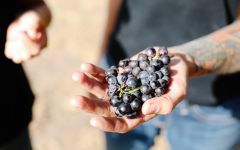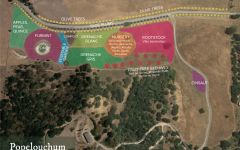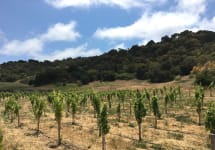Bonny Doon Vin Gris de Cigare 2019
-
Wilfred
Wong -
Wine
Enthusiast



Product Details
Your Rating
Somm Note
Winemaker Notes
The 2019 Bonny Doon Vin Gris de Cigare opens with typical rose notes: wild strawberry, peach, guava, and rhubarb and a very discreet scent of white pepper. The wine has a wonderful creaminess and length on the palate in virtue due to the practice of leaving the wine post-fermentation on its lees to great effect.
Blend: 79% Grenache, 5% Grenache Gris, 5% Grenache Blanc, 5% Vermentino, 3% Cinsault, 1.5% Picpoul, 1.5% Clairette Blanche
Professional Ratings
-
Wilfred Wong of Wine.com
COMMENTARY: The Bonny Doon Vineyard Vin Gris de Cigar is literally, "The Pink Wine of the Earth." This iconic wine is one of the best in the genre of rosé wines. The 2019 vintage is one of the winery's best to date. TASTING NOTES: This is a beautiful and real wine. Its classic and attractive aromas and flavors of dried earth and red berries stay long and crisp on the palate. Enjoy it with a selection of cheeses, deli meats, and pâtés. (Tasted: April 11, 2020, San Francisco, CA)
-
Wine Enthusiast
Light raspberry, delicate cotton candy, brisk melon and a hint of citrus show on the nose of this pale rosé. There's a great zip and tense texture to the sip, where ash and talc flavors meet with rounded red plum, strawberry and watermelon, all sliced by strong acidity. Best Buy.
Other Vintages
2021-
Wilfred
Wong
-
Wine
Enthusiast -
Wilfred
Wong -
Tasting
Panel
-
Wilfred
Wong -
Tasting
Panel
-
Tasting
Panel -
Wine &
Spirits
-
James
Suckling
-
Wine
Spectator
-
Robert
Parker
-
Wine
Enthusiast
-
Wine
Enthusiast
-
Wine
Enthusiast
-
Wine
Spectator






While Bonny Doon Vineyard began with the (in retrospect) foolish attempt to replicate Burgundy in California, Randall Grahm realized early on that he would have far more success creating more distinctive and original wines working with Rhône varieties in the Central Coast of California. The key learning here (achieved somewhat accidentally but fortuitously) was that in a warm, Mediterranean climate, it is usually blended wines that are most successful. In 1986 Bonny Doon Vineyard released the inaugural vintage (1984) of Le Cigare Volant, an homage to Châteauneuf-du-Pape, and this continues as the winery’s flagship/starship brand.
Since then, Bonny Doon Vineyard has enjoyed a long history of innovation – the first to truly popularize Rhône grapes in California, to successfully work with cryo-extraction for sundry “Vins de Glacière, the first to utilize microbullage in California, the first to popularize screwcaps for premium wines, and, quite significantly, the first to embrace true transparency in labeling with its ingredient labeling initiative. The upside of all of this activity has brought an extraordinary amount of creativity and research to the California wine scene; the doon-side, as it were, was perhaps an ever so slight inability to focus, to settle doon, if you will, into a single, coherent direction.1
Bonny Doon Vineyard grew and grew with some incredibly popular brands (Big House, Cardinal Zin and Pacific Rim) until it became the 28th largest winery in the United States. Randall came to the realization – better late than Nevers – that he had found that the company had diverged to a great extent from his original intention of producing soulful, distinctive and original wines, and that while it was amusing to be able to get restaurant reservations almost anywhere (the only real tangible perk he was able to discern from the vast scale of the operation), it was time to take a decisive course correction. With this in mind, he sold off the larger brands (Big House and Cardinal Zin) in 2006 and Pacific Rim in 2010.
In the intervening years, the focus of the winery has been to spend far more time working with vineyards in improving their practices, as well as on making wines with a much lighter touch – using indigenous yeast whenever possible, and more or less eschewing vinous maquillage, (at least not to Tammy Faye Bakker-like levels). Recently, Randall has purchased an extraordinary property in San Juan Bautista, which he calls Popelouchum, (the Mutsun word for “paradise,”) where he is profoundly intent on producing singular wines expressive of place. There are also very grand plans afoot to plant a dry-farmed Estate Cigare vineyard.

Whether it’s playful and fun or savory and serious, most rosé today is not your grandmother’s White Zinfandel, though that category remains strong. Pink wine has recently become quite trendy, and this time around it’s commonly quite dry. Since the pigment in red wines comes from keeping fermenting juice in contact with the grape skins for an extended period, it follows that a pink wine can be made using just a brief period of skin contact—usually just a couple of days. The resulting color depends on grape variety and winemaking style, ranging from pale salmon to deep magenta.

The largest and perhaps most varied of California’s wine-growing regions, the Central Coast produces a good majority of the state's wine. This vast California wine district stretches from San Francisco all the way to Santa Barbara along the coast, and reaches inland nearly all the way to the Central Valley.
Encompassing an extremely diverse array of climates, soil types and wine styles, it contains many smaller sub-AVAs, including San Francisco Bay, Monterey, the Santa Cruz Mountains, Paso Robles, Edna Valley, Santa Ynez Valley and Santa Maria Valley.
While the Central Coast California wine region could probably support almost any major grape varietiy, it is famous for a few Central Coast reds and whites. Pinot Noir, Chardonnay, Cabernet Sauvignon and Zinfandel are among the major ones. The Central Coast is home to many of the state's small, artisanal wineries crafting unique, high-quality wines, as well as larger producers also making exceptional wines.
